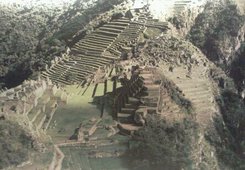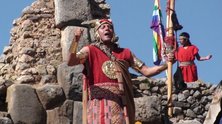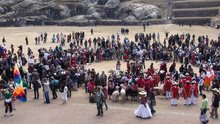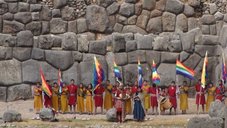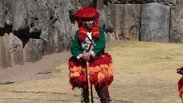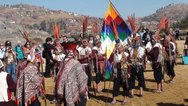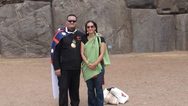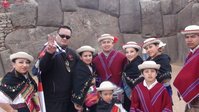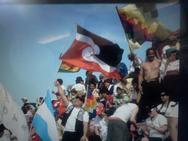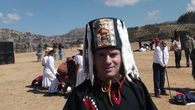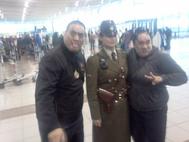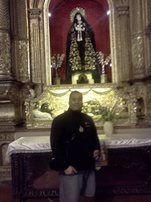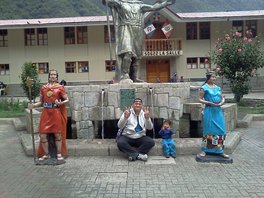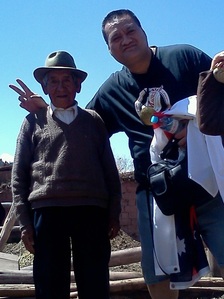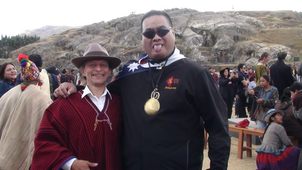Can you please introduce yourself…your pepeha if you like
Tena koutou katoa on my father’s side I am from Tainui waka, my iwi are Ngati Mahanga and Ngati Mahuta. I’m Tainui Awhiro from Poehakena Marae in Whaingaroa- Raglan, and on my Ngati Mahuta side from Turangawaewae marae. On my mothers side I am from Mamari waka, Ngatokimatawhaorua waka and Tinana Waka. My iwi are, Ngati Kaahu, Ngati Hine and Ngati Manawa. My name is Rawiri (David) Waretini-Karena and I am over in South America representing two tertiary institution providers. The first is Te Whare Wananga o Awanui-a-Rangi where I am studying a PhD Doctorate of Philosophy in Indigenous studies and as a result of that study am presenting some of my research. The second is the Waikato Institute of Technology (WINTEC) where I am a lecturer in the Bachelor of Applied Social Science degree specializing in Te Whiuwhiu o te Hau Maori counselling. As official as it sounds I also acknowledge that I am standing on the backs of giants who paved the way for me to be a part of this journey so therefore ultimately represent my Tupuna, my culture, and my whanau.
Can you please give me a timeline of events from the time you left NZ
(up to the time you expect to leave South America)?
We left New Zealand on Thursday 11th August and travelled to Santiago Chile where we stayed for the night in a 5 star hotel called the Holiday Inn. Chile is almost a day behind, as we left Auckland at 420pm Thursday and arrived at 1130am Thursday morning. The flight took over ten hours and was very cramped but the anticipation of heading to a part of the world where there is evidence that the Maori also has whakapapa links to it was too good an opportunity to miss. After getting the chance to travel around we boarded a plane for a four hour flight to Lima and then another 1 hour flight to Cusco Peru.
Saturday 13th August We registered our presence
Sunday 14th August Was the opening ceremony held up at Sachisaywaman- an ancient Temple of the Mayans-
Monday 15th August International presentations began and run for three days
Tuesday 16th August presentations continued
Wednesday 17th August “ “ “ “ “and conclude
Thursday 18th August we travel to an impoverished village and spend time with the community
Then we return to Cusco and commence with the closing ceremony
Friday 19th August We travel by train through the sacred Inca valley and take a bus trip to Machu Pichu, one of the wonders of the world. I would have liked to have travelled to the Nasca lines as well as lake Titikaka however our agenda has been really full on.
Saturday 20th August we spend time in the local village at Machu Pichu and then return to Cusco
Sunday 21st August we travel from Cusco to Lima and then Santiago and then from Santiago to New Zealand. All up we spend 18 hours in the air returnning 430am Tuesday 23rd August.
Saturday 13th August We registered our presence
Sunday 14th August Was the opening ceremony held up at Sachisaywaman- an ancient Temple of the Mayans-
Monday 15th August International presentations began and run for three days
Tuesday 16th August presentations continued
Wednesday 17th August “ “ “ “ “and conclude
Thursday 18th August we travel to an impoverished village and spend time with the community
Then we return to Cusco and commence with the closing ceremony
Friday 19th August We travel by train through the sacred Inca valley and take a bus trip to Machu Pichu, one of the wonders of the world. I would have liked to have travelled to the Nasca lines as well as lake Titikaka however our agenda has been really full on.
Saturday 20th August we spend time in the local village at Machu Pichu and then return to Cusco
Sunday 21st August we travel from Cusco to Lima and then Santiago and then from Santiago to New Zealand. All up we spend 18 hours in the air returnning 430am Tuesday 23rd August.
What is the hui all about?
The hui is called WIPCE or World Indigenous Peoples Conference on Education which is held globally every two years. The last time it was held in New Zealand was 2005. WIPCE is an opportunity for all indigenous cultures around the world to connect, to share knowledge, to create and expand global networks and to see how other indigenous cultures are faring in their own whenua. What makes this WIPCE conference so unique is that it is the first conference where we are in a country where the dominant culture is brown and where only a limited amount of people speak English.
How many different countries were there and what to you were some of the interesting ones?
Many counties were involved in WIPCE, delegates came from Alaska, Canada, North America, Brazil, Mexico, Ecuador, Columbia, Argentina, Bolivia, Chile, Hawaii, Australia, New Zealand and of course Peru.
Can you tell us about your presentation?
My presentation is called Takitoru-from Parallel to Partnership. It is a framework that utilises Te Tiriti o Waitangi as a ritual of engagement for safe cultural practice in Maori Counselling and Social Science. It talks about having two stake holders in New Zealand and asks how we can come into shared space with each other yet still keep our dignity, our integrity and ultimately our autonomy. My frame work advocates learning about the history of colonisation from the 10th century on wards so that indigenous peoples globally can gain scope into how the history of colonisation was created. It also does a critical analysis using the Te Tiriti o Waitangi as a foundation in terms of what was agreed to share and what our Tangata whenua agreed to keep. It brings to the fore the Te Tiriti o Waitangi document as a pinnacle element that formed the basis of a relationship between two peoples. From there it steps into the Te Tiriti o Waitangi violations and highlights how Tangata whenua Maori were attacked in three different areas. 1) Legislation was used to strip away land and resources, 2) Block any form of accountability and challenge to the fraudulent practices of the NZ Settler Government. 3) Legislation was used to assimilate our culture, our practices and our identity. I then get my students to contextualize the violations of Te Tiriti o Waitangi over their own whanau using a historical context, a societal context, an institutional context, and then a personal context. From then I get my students to research their own whanau over four generations dating back to 1840 and then I get them to superimpose the treaty of Waitangi violations over the top. I then ask them to research their whanau history and the environment their whanau grew up in. They then do a holistic analysis over those four generations discussing the spiritual impacts, the emotional impacts, the environmental impacts as well as the physical impacts. As they begin to articulate the history of their whanau pictures begin to emerge, then I get students to do a geneogram of examples of symptoms of historical intergenerational trauma that filtered from one generation to the next for example intergenerational impoverishment, alcohol, drugs, gangs, alcohol. Most families identify these examples of symptoms that occur in their own family history, however they have had little understanding of where it all initially came from in terms of the the Te Tiriti o Waitangi violations. We then look at how we transform the status quo however that is for another chapter.
What are some of the ideas being discussed among nations?
One of the big issues in Peru is the building of 66 dams by Brazil for the purpose of flooding the Amazon river and dislocating and in some cases exterminating the local tribes that live deep in the jungle. The damming of the Amazon will also impact on Peru as the Amazon also flows through both Peru and other South American countries. In 2009 there was a war between the Peru Government and the indigenous peoples of the Amazon as the Peru Government allowed the American Corporations to drill and use chemicals that have literally destroyed the rain forest. A lot of people died but as a result the Peru government backed off and was voted out of office.
Any completely revolutionary ideas presented?
Bentham Ohia the CEO of Te Wananga o Aotearoa talked about transformative practice through the global unification of all indigenous cultures under the declaration of the rights of indigenous peoples and has been actively working at this since 2007.
Awanui Black presented on Tawhaki vs Maui. His was really interesting in terms of him coming to Peru to look for whakapapa that connects Tawhaki to Peru & Machu Pichu. The Peruvian Indigenous peoples have a story of Tawhaki. The Inca/Mayan King that ordered the building of Machu Pichu had two sons who were in charge of its construction. After the completion there was a falling out between the two brothers. Tawhaki the younger was exiled from the kingdom. His whakapapa was traced to Tahiti where he became part of the Kamehameha line that migrated to Hawaii and eventually ended up in Aotearoa NZ. The details are still being discussed in terms of the whakapapa however the fact that they have a whakapapa record of that name was astounding. They also have fish in lake Titikaka called the Maori and part of their traditional kai is Kamo kamo, kumara, and Peruperu potatoes. The Peruvian guides that I met all say that the accepted theories of their country say that Polynesians were in Peru.
Awanui Black presented on Tawhaki vs Maui. His was really interesting in terms of him coming to Peru to look for whakapapa that connects Tawhaki to Peru & Machu Pichu. The Peruvian Indigenous peoples have a story of Tawhaki. The Inca/Mayan King that ordered the building of Machu Pichu had two sons who were in charge of its construction. After the completion there was a falling out between the two brothers. Tawhaki the younger was exiled from the kingdom. His whakapapa was traced to Tahiti where he became part of the Kamehameha line that migrated to Hawaii and eventually ended up in Aotearoa NZ. The details are still being discussed in terms of the whakapapa however the fact that they have a whakapapa record of that name was astounding. They also have fish in lake Titikaka called the Maori and part of their traditional kai is Kamo kamo, kumara, and Peruperu potatoes. The Peruvian guides that I met all say that the accepted theories of their country say that Polynesians were in Peru.
Within our roopu 'Alternative Maori Media' some members have begun to 'research' open source or crowd source education - with the intention of encouraging ideas about how to use social media technology to enhance education.... Was 'open source or crowd source technology discussed at all and if so what conclusions were reached?
Peru is still a very third world country and they are not as technology savvy as Aotearoa New Zealand. There was also the language barrier that we had to overcome before there was any more discussion of any other type of open source or crowd source technology. It was pretty much power point and speak.
Any surprises with the hui or the trip?
Probably one of the big surprises on the trip especially in Santiago was dealing with hustlers and con artists. For our people to go to Chile they have to be quite canny and keep their wits about them. I followed a group of people on a tour around Santiago. The tour bus took us straight to a restaurant where they were hustled into a dinning area. Then the restaurant proceeded to bring out the most expensive menus. One of the group tried King crab not realizing it was $100.00 US. Some got stung pretty hard and on top of that got food poisoning. I didn’t like the situation so got up and walked out at the beginning and found an even cheaper shop around the corner.
I felt Chile was very business orientated and had set up a whole network aimed at the tourist dollar of which they all get a cut. They have an infrastructure setup in which to capture the tourist market.
Peru is different, although it is tourist focused, they are not as pushy, they really do need the money and so they have put honest labour into their work. They know the value of tourism so work to make your stay with them as comfortable as possible. I saw one incident where an intoxicated European tried to walk off without paying for a taxi fare and when he was challenged over payment decided to have a go at the taxi driver. Unfortunately for the European the Peruvian was a better fighter, he ended up paying up however if he hadn’t there was a whole van load of Maoris sitting in the van watching him.
The Place & People
The Peruvian people are amongst the most humble people you can ever meet. They remind me of values and principles my old kaumatua and kuia had where they would open their homes and hearts to any one who was a manuhiri on their land. There is no welfare in Peru and every one gets by on their skill and talents. They are very ringa raupa, or hard working people. They know what it is to be with out and yet the communal environment they live in is very close knit.
Can you please give us your impressions of the landscape and the people?
Peru is a third world country and one of the things I have begun to appreciate are the things we take for granted. I saw child slavery, shanty towns that looked more like rubbish tips. One of the things that really stood out for me is that I went to a restaurant and in it were foreigners. Yet as I looked out the window I became very aware of the Indigenous peoples outside the windows watching us eat. I very quickly became aware of the essence of white privilege, and that I was participating in it. The people who were natives to the land were not allowed through the door. We were like movie on a television and they were gazing upon us
Highlights of your trip...
Everything I did was a highlight. Going to Saqsaywaman- an ancient Mayan Temple in Cusco and seeing every other indigenous culture there dressed up was amazing. Walking on those grounds, with the He Whakaputanga flag and representing my tupuna was amazing, gaining an insight into other cultures and the fact that they allowed us a glimpse into their way of life. Walking on Machu Pichu with my He Whakaputanga Declaration of Independence 1835 flag. Officials at the Machu Pichu border before you go on to the site stopped me and told me to remove my flag and I refused, so they went and got the security to remove me from Machu Pichu not realizing that I was part of the NZ delegation for WIPCE. Their reasoning was that it was forbidden to have other country flags up there but when I asked what the basis of those grounds were they could not give any definitive answers. I ended up speaking with one of the security heads and pointed to their independence flag and told them that it meant the same thing, and that my ancestors were represented in this flag and that it was about achieving the same goals. They ended up letting me carry it onto the site.
Any scary moments?
One of the scariest issues is altitude sickness, it is very real, it feels like you are suffocating and need to acclimatize and take things very easy and not bee in too much of a rush to go anywhere or do anything. Some people fainted and were taken to hospital to be oxygenized because the air is so thin you have to breath extra harder to catch a breath. It causes headaches, fainting, breathlessness and dizzy spells. I was lucky in that I took my time, a doctor said that every hour you have to take 5 deep breaths just to get more oxygen into your lungs. One of the remedies that really helps is Coca tea or coca leaves. Once it is processed it is used to make cocaine however in its pure leaf form, it is one of the best remedies for high altitude sickness
You have a picture with one of Perus most renown shamans, did he have any korero to share with you about Maori or any of his own tribal prophesies?
He did a drum dance and chants that were very powerful; you could feel the mauri in his words even though he was speaking ancient Qechuan language
He did a drum dance and chants that were very powerful; you could feel the mauri in his words even though he was speaking ancient Qechuan language
Any talk of the Mayan calendar?
The main talk was about the unification of the Indigenous cultures and the learning from each other. The Mayan calendar seems to be a natural part of the mix moving towards the future. From the little that was spoken about the Mayan calendar every one that spoke seemed to agree that it is a changing from one age to another. Other than that not much else was said. Pachu Mama or Papatuanuku was the main focus and about how we the indigenous peoples who are the recognized guardians of Mother Earth were to help her heal was the korero. What they did discuss was that Pachu Mama or Papatuanuku was going to heal herself regardless however what part we play is also significant.
Any experience of indigenous ceremony while there?
The opening ceremony was amazing, the Peruvians did a reproductions of their history and legends and then weaved it into the opening ceremony that included every indigenous culture. The Peruvians are small in stature however have huge lung capacity. While all foreigners are left breathless, they can run non stop at high altitude and have no effects at all.
.
Anything else that sticks out about your trip that you want to share?
Anything else that sticks out about your trip that you want to share?
I learnt very early do not pretend you can speak Spanish. On our on board LAN flight there is an area that teaches to speak Spanish. Having thought that I had mastered a few phrases I decided to try them on the flight attendant then was convinced I could speak until I went completely blank and had to admit no hablo espanyol. I now mix 3 languages together, English Maori & Spanish. Only some one else from the delegation would understand that. I loved the fact that I had to reach out of my comfort zone to learn another language it was good for my overall growth.
Also a shout out to the hotel Qarmenqa crew, I made amazing new friends had awesome experiences and gained ever lasting memories garacias.
Also a shout out to the hotel Qarmenqa crew, I made amazing new friends had awesome experiences and gained ever lasting memories garacias.
Kia ora Rawiri..thank you for your comprehensive answers and for providing what has been a very interesting and informative read.
Readers - If you wish to comment please do so at: https://www.facebook.com/groups/AlternativeMaoriMediaPlatform/
For more information on the struggle for the Indigenous of Peru to stop the building of 66 dams (to dam the Amazon) by the Brazilian government
Article http://lacymacauley.wordpress.com/2009/06/10/the-violent-face-of-free-trade-government-forces-kill-indigenous-peruvians-defending-the-amazon/
Video http://sixtyminutes.ninemsn.com.au/article.aspx?id=8270648

